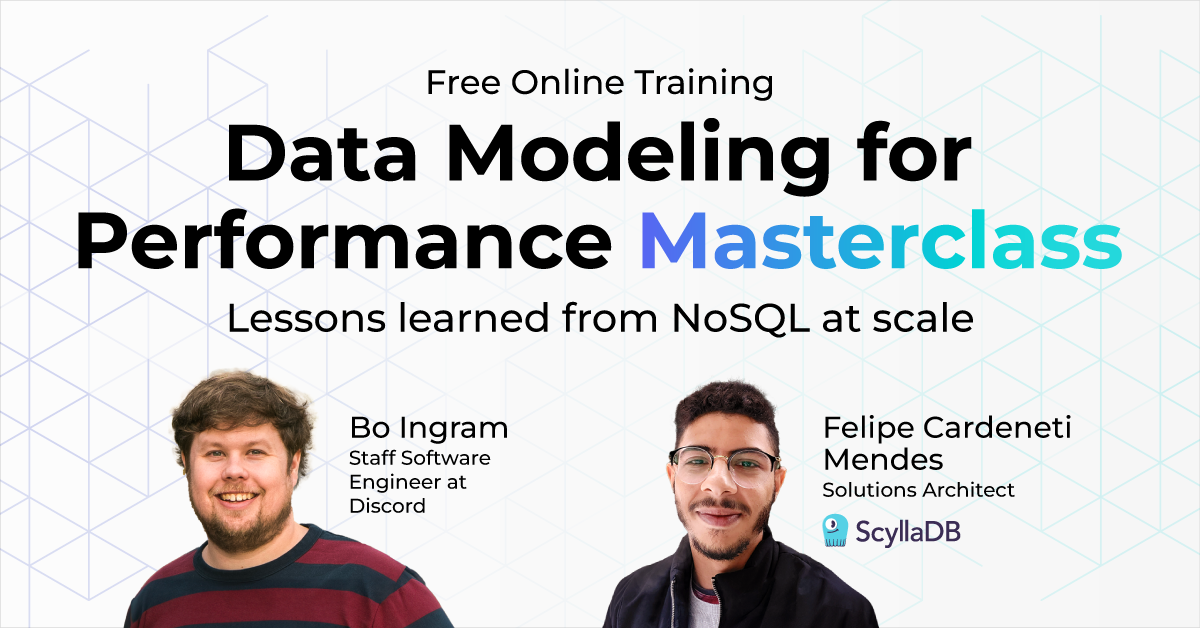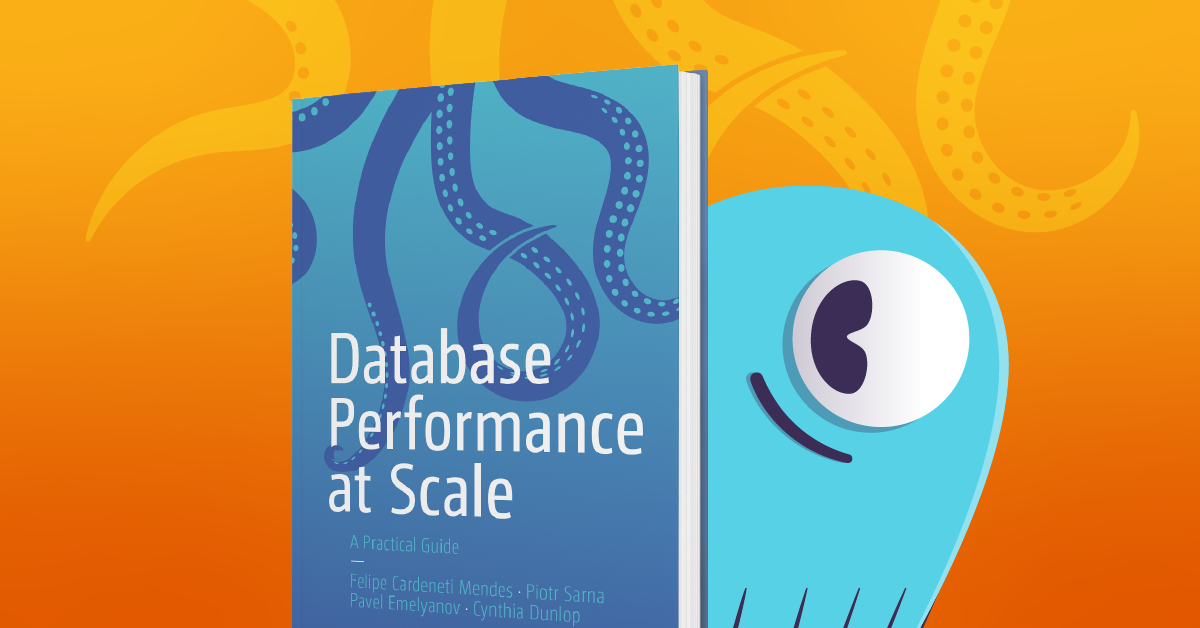
How does ScyllaDB compare to other databases? Read what Bo Ingram (Staff Engineer at Discord) has to say – in this excerpt from his new book “ScyllaDB in Action.”
Editor’s note
We’re thrilled to share the following excerpt from Bo Ingram’s informative – and fun! – new book on ScyllaDB: ScyllaDB in Action. It’s available now via Manning and Amazon. You can also access a 3-chapter excerpt for free, compliments of ScyllaDB.
Get the first 3 book chapters, free
You might have already experienced Bo’s expertise and engaging communication style in his blog How Discord Stores Trillions of Messages or ScyllaDB Summit talks How Discord Migrated Trillions of Messages from Cassandra to ScyllaDB and So You’ve Lost Quorum: Lessons From Accidental Downtime If not, you should 😉 And if you want to learn more from Bo, join him at our upcoming Masterclass: Data Modeling for Performance Masterclass. We’ve ordered boxes of print books and will be giving them out!
Watch Bo at the “Data Modeling for Performance” Masterclass — Now On Demand

This blog post shares how ScyllaDB compares to:
- Relational databases
- Apache Cassandra
- Amazon DynamoDB
- Google Cloud Spanner
- MongoDB
- Distributed relational databases (CockroachDB, TiDB, and YugabyteDB)
The following is an excerpt from Chapter 1; it’s reprinted here with permission of the publisher.
ScyllaDB versus relational databases
ScyllaDB runs multiple nodes, making it a distributed system. By spreading its data across its deployment, it uses that to achieve its desired availability and consistency, which, when combined, differentiates the database from other systems.
I’ve introduced ScyllaDB by describing its features in comparison with relational databases, but we’ll examine in closer detail here the differences. Relational databases such as PostgreSQL and MySQL are the standard for data storage in software applications, and they’re almost always the default choice for a new developer looking to build an application. Relational databases are a very strong option for many use cases, but that doesn’t mean they’re a strong option for every use case.
ScyllaDB is a distributed NoSQL database. By distributing data across a cluster, ScyllaDB unlocks better availability when nodes go awry than a single-node all-or-nothing relational database. PostgreSQL and MySQL can run in a distributed mode, but that is either powered through extensions or newer storage engines and not the primary native mode of the database. This distribution is native to ScyllaDB and the bedrock of its design.
By running as a distributed system, ScyllaDB empowers horizontal scalability. Many relational databases are only vertically scalable – you can only add more resources by running it on a bigger server. With horizontal scalability, you can add additional nodes to a system to increase its capacity. ScyllaDB supports this expansion; administrators can add more nodes, and the cluster will rebalance itself, offloading data to the new cluster member. In a relational database, horizontal scaling is possible, but it’s often manual. Operators need to manually shard data between multiple nodes to achieve this behavior.
ScyllaDB does not provide a relational database’s ACID (atomicity, consistency, isolation, and durability) guarantees, instead opting for a softer model called BASE (Basic Availability, Soft-state, and Eventual consistency), where the database has basic availability and is eventually consistent. This decision leads to faster writes than a relational database, which has to validate the consistency of the database after every write, whereas ScyllaDB only needs to save the write since it doesn’t promise that degree of correctness. The tradeoff, though, is that developers need to consider ScyllaDB’s weaker consistency. … Ultimately, ScyllaDB versus relational databases is a foundational and philosophical decision. They operate so differently and provide such varying guarantees to their clients that picking one over the other has large effects on an application. If you’re looking for availability and scalability in your database, ScyllaDB is a strong option.
ScyllaDB versus Cassandra
ScyllaDB is a rewrite of Apache Cassandra. It is frequently described as “a more performant Cassandra” or “Cassandra but in C++”. ScyllaDB is designed to be compatible with Cassandra: it uses a compatible API, query language, on-disk storage format, and hash ring architecture. Like Cassandra, but better, is ScyllaDB’s goal; it makes some improvements to accomplish this.
The choice of language in the rewrite immediately unlocks better performance. Cassandra is written in Java, which leverages a garbage collector to perform memory management. Because objects get loaded into memory, at some point, they will need to be removed. Java’s garbage collection algorithms handle this removal, but it comes at the cost of compute. Time spent garbage collecting is time Cassandra can’t spend executing queries. If garbage collection reaches a certain threshold, the Java Virtual Machine will pause all execution for a brief time while it cleans up memory, referred to as a “stop the world” pause. Even if it’s just for milliseconds, that pause can be painful to clients. Although Java exposes many configuration knobs and improves the garbage collector with each release, it’s a tax that all Java-based applications have to pay — whether in garbage collection time or time spent mitigating it.
ScyllaDB avoids this tax because it is implemented in C++ and provides more granular controls for memory management. By having full control of memory allocation and cleanup, ScyllaDB doesn’t need to let a garbage collector perform this functionality on an application-wide scale. It avoids “stop the world” pauses and can dedicate its compute time to executing queries.
ScyllaDB’s biggest architectural difference is its shard-per-core architecture (figure 1.9). Both Cassandra and ScyllaDB shard a data set across its various nodes via placement in a hash ring, which you’ll learn more about in chapter 3. ScyllaDB takes this further by leveraging the Seastar framework (https://seastar.io/) to shard data within a node, splitting it up per CPU-core and giving each shard its own CPU, memory, and network bandwidth allocation.

Figure 1.9 ScyllaDB shards data not only within the cluster, but also within each instance.
This sharding further limits the blast radius due to hot traffic patterns – the damage is limited to just that shard on that node. Cassandra does not follow this paradigm, however, and limits the sharding to only per node. If a data partition gets a large amount of requests, it can overwhelm the node, leading to cluster-wide struggles.
Performance justifies the rewrite. Both in benchmarks (https://thenewstack.io/benchmarking-apache-cassandra-40-nodes-vs-scylladb-4-nodes/) and in the wild (https://discord.com/blog/how-discord-stores-trillions-of-messages), Scylladb is faster, more consistent, and requires fewer servers to operate than Cassandra.
ScyllaDB versus Amazon Aurora / Google Cloud Google / Spanner AlloyDB
I’ve lumped a few similar systems together here – Amazon Aurora, Amazon DynamoDB, Google Cloud Spanner, and Google AlloyDB. They can be generally described as scalable cloud-hosted databases. They aim to take a relational data model and provide greater scalability than out-of-the-box PostgreSQL or MySQL. This effort accentuates a need in the market for scalable databases, showing the value of ScyllaDB.
These systems have two related drawbacks – cloud vendor lock-in and cost. As cloud providers provide these databases, they run in only that specific vendor’s cloud environment. You can’t run Google Cloud Spanner in Amazon Web Services. If your application is heavily dependent on one of these systems, there can be a high engineering cost if you decide to switch cloud providers, as you’ll need to migrate data into a different system with a potentially different storage paradigm.
If you’re not using that provider (or any provider), these options aren’t even on the table for you. And by using a cloud provider, companies pay money for these services. Operating and maintaining a database is challenging (which is partly why you’re reading this book), and although these cloud vendors provide solutions to make it potentially simpler, that can get quite expensive for clients. Of course, operating a database yourself can also be costly.
ScyllaDB, however, can be run anywhere. Companies are running it on-premises or within various cloud providers. It provides a scalable and fault-tolerance database that you can take to any hosting solution.
ScyllaDB versus document stores
I’m not talking about Google Drive here, but instead, databases that store unstructured documents by a given key, such as MongoDB. These systems support querying these documents, allowing users to access arbitrary document fields without defining a database schema.
ScyllaDB eschews this flexibility to provide (relatively) predictable performance. By requiring users to define their schema up front, it clarifies to both users and the system how data is distributed across the cluster. By forcing users to query data in patterns that match this distribution, ScyllaDB can limit the number of nodes involved in a query, preventing surprisingly expensive queries.
Document stores, on the other hand, tend to bias toward initial ease of use. In MongoDB, no schema definition is required, but users still need to consider the design of their data to query it effectively. MongoDB runs as a distributed system, but unlike ScyllaDB, it doesn’t out-of-the-box attempt to minimize inefficient queries that hit more than the expected number of nodes, leading to potential performance surprises.
In the CAP theorem, MongoDB is a CP (consistent and partition-tolerant) system. Writes require the presence of a primary node and are blocked until a new primary is elected in the event of a network partition. ScyllaDB, however, prioritizes availability in its query path, keeping the system up and relying on its tunable consistency.
ScyllaDB versus distributed relational databases
One interesting development for databases over the past few years has been the growth of distributed transactional databases. These systems — such as CockroachDB, TiDB, and YugabyteDB — focus on improving the availability of a traditional relational database like PostgreSQL while still offering strong consistency. In the CAP theorem’s classifications, they’re CP systems; they prefer consistency over availability. By emphasizing correctness, they need a quorum of nodes to respond to successfully complete a query; if quorum is lost, the database loses availability. ScyllaDB, however, provides tunable consistency to dodge this problem. By allowing weaker consistency levels, such as ONE, Scylla can handle a greater loss of availability to preserve functionality.
In a relational database, writes are the computationally intensive operation. The database needs to validate its consistency on every write. Scylla, on the other hand, skips this verification, opting for speed and simplicity when writing data. The tradeoff, however, is that reads in Scylla will be slower than writes, as you need to gather data from multiple nodes that have data stored in different places on disk. You’ll learn a lot more about this behavior in chapters 6 and 7, but the big takeaway is that writes in Scylla will be faster than in these systems.
When to prefer other databases
I’ve described ScyllaDB’s benefits relative to other databases, but sometimes, I admit, it’s not the best tool for the job. I can’t describe it as a unique database because of the Cassandra rewrite approach, but it does trade operational and design complexity for more graceful failure modes. Choosing Scylla requires you to design applications differently because it has specific data-modeling needs to best use its capabilities and adds more complexity than something like a cloud-hosted PostgreSQL server. If you don’t need ScyllaDB’s horizontal scalability and nuanced availability, the increased operational overhead might not be worth it. If your application is small, makes few requests, and isn’t expected to grow over time, ScyllaDB might be overkill. A database backing comments on your blog probably doesn’t need a ScyllaDB cluster, unless, like many of us, you’re wanting that as an excuse to try it out.
Operating and maintaining a ScyllaDB cluster isn’t a hands-off exercise. If you can’t dedicate time to operating and maintaining a cluster, that is another signal that a managed offering might be preferable for you. Teams must choose wisely about how they spend their time and their money on what they do; choosing a less hands-on is a valid decision.
One thing you’ll see about Scylla in upcoming chapters is that, with data modeling, it can be inflexible to change your database’s design. Adding new query patterns that don’t fit in with your initial design can be challenging. While there are ways to work around it, other databases can potentially give you more flexibility when you’re in the prototyping and learning stage of building features for an application.
Lastly, some use cases might prefer a stronger transactional model like ACID. If you’re working with financial data, you might want to use a relational database so that you can have isolation in your operations. One popular example to demonstrate the importance of ACID transactions is concurrent access to bank accounts. Without isolation, you run the risk of concurrent operations causing a mismatch between how much money the database thinks you have and how much money you actually have. Accountants traditionally prefer accuracy in these areas, so you might prefer a relational database when working with something that needs stronger database transactions. While scaling a relational database has its challenges, they might be preferable to take on than surrendering ACID’s guarantees. Scylla can get closer to ACID through careful design and usage of some more advanced features you’ll learn about in chapter 6, but it’s not quite as an “out-of-the-box” experience as a relational database.



